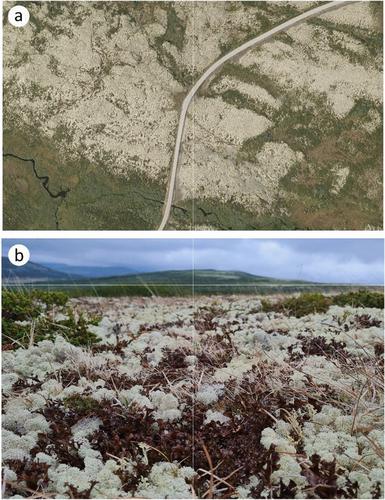Oecologia ( IF 2.7 ) Pub Date : 2024-01-17 , DOI: 10.1007/s00442-023-05498-4 Knut Asbjørn Solhaug , Gaute Eiterjord , Martine Hana Løken , Yngvar Gauslaa

|
The mat-forming fruticose lichens Cladonia stellaris and Cetraria islandica frequently co-occur on soils in sun-exposed boreal, subarctic, and alpine ecosystems. While the dominant reindeer lichen Cladonia lacks a cortex but produces the light-reflecting pale pigment usnic acid on its surface, the common but patchier Cetraria has a firm cortex sealed by the light-absorbing pigment melanin. By measuring reflectance spectra, high-light tolerance, photosynthetic responses, and chlorophyll fluorescence in sympatric populations of these lichens differing in fungal pigments, we aimed to study how they cope with high light while hydrated. Specimens of the two species tolerated high light equally well but with different protective mechanisms. The mycobiont of the melanic species efficiently absorbed excess light, consistent with a lower need for its photobiont to protect itself by non-photochemical quenching (NPQ). By contrast, usnic acid screened light at 450–700 nm by reflectance and absorbed shorter wavelengths. The ecorticate usnic species with less efficient fungal light screening exhibited a consistently lower light compensation point and higher CO2 uptake rates than the melanic lichen. In both species, steady state NPQ rapidly increased at increasing light with no signs of light saturation. To compensate for less internal shading causing light fluctuations with a larger amplitude, the usnic lichen photobiont adjusted to changing light by faster induction and faster relaxation of NPQ rapidly transforming excess excitation energy to less damaging heat. The high and flexible NPQ tracking fluctuations in solar radiation probably contributes to the strong dominance of the usnic mat-forming Cladonia in open lichen-dominated heaths.
中文翻译:

非光化学猝灭可能有助于形成苍白垫状地衣 Cladonia stellaris 相对于同域黑色素 Cetraria islandica 的优势
形成席子的果状地衣Cladonia stellaris和Cetraria islandica经常同时出现在暴露于阳光的北方、亚北极和高山生态系统的土壤中。占主导地位的驯鹿地衣Cladonia缺乏皮质,但在其表面产生反光的浅色色素松萝酸,而常见但斑驳的Cetraria则具有由吸光色素黑色素密封的坚固皮质。通过测量这些真菌色素不同的地衣同域种群的反射光谱、高光耐受性、光合反应和叶绿素荧光,我们的目的是研究它们在水合时如何应对强光。这两个物种的标本对强光的耐受性同样好,但保护机制不同。黑色素物种的真菌生物体有效地吸收了多余的光,这与其光生物体通过非光化学猝灭(NPQ)保护自身的需求较低相一致。相比之下,松萝酸通过反射率屏蔽 450-700 nm 的光并吸收较短的波长。与黑色地衣相比,具有较低效率的真菌光屏蔽的皮质USNIC物种表现出持续较低的光补偿点和较高的CO 2吸收率。在这两个物种中,稳态 NPQ 在光照增加时迅速增加,没有光饱和的迹象。为了补偿导致光波动幅度较大的内部阴影较少,美国地衣光生物通过更快的诱导和更快的 NPQ 弛豫来适应变化的光,从而将多余的激发能迅速转化为破坏性较小的热量。太阳辐射中高而灵活的 NPQ 跟踪波动可能有助于形成美国垫子的克拉多尼亚 ( Cladonia)在开放地衣为主的荒地中占据主导地位。



























 京公网安备 11010802027423号
京公网安备 11010802027423号